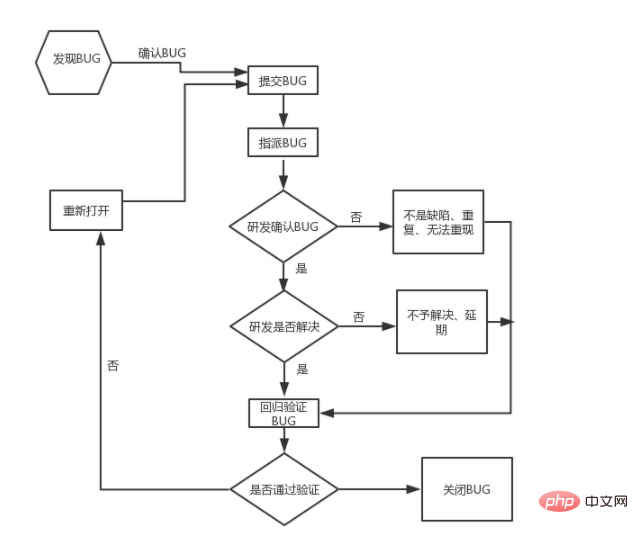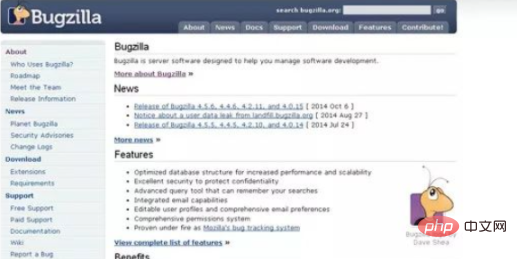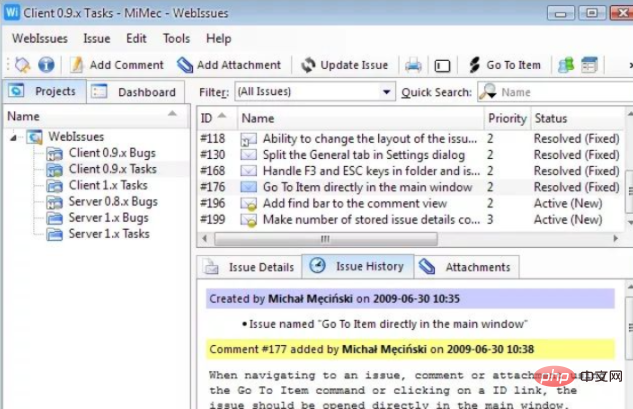What is the life cycle of a bug?
The life cycle of a BUG is the process from when a BUG is discovered to when the BUG is closed. The specific process is: 1. Discover the BUG, that is, discover the loopholes or defects in the software program; 2. Submit the bug and try to describe it as much as possible. Defect attributes, reproduction environment, type, level, priority, detailed reproduction steps, results and expectations, etc.; 3. Assign the bug, that is, assign the problem directly to the corresponding developer; 4. Analyze and confirm it as a defect; 5. , handle and fix BUG; 6. Regression verification BUG; 7. Close BUG.

The operating environment of this tutorial: Windows 7 system, Dell G3 computer.
What is a bug
Software BUG, in the narrow sense, can be understood as referring to the loopholes or defects of the software program. In the broad sense, in addition to finding the program, it also includes test engineers or users The details of the discovered and proposed software that can be improved, or the functional implementation that is different from the requirements document, etc. That is, the intervention of testing can start from demand analysis and track the development process.
The life cycle of a bug
The life cycle of a BUG is the process from when a BUG is discovered to when the BUG is closed.
Defect status in the life cycle: New-->Assigned-->Resolved-->Pending-->Close
BUG found-->Submit BUG–>Assign BUG–>R&D to confirm BUG–>R&D to fix BUG–>Regression verification BUG–>Whether it passes verification–>Close BUG
If the BUG to be checked is not resolved during verification, we need to re-open--Assignment--Resolved--To be checked, and cycle this process.
Other states in the middle: rejection, postponement, etc.
BUG processing flow chart (life cycle diagram)

1. Discover bugs
a. Follow the test case and find anything inconsistent with the expected results of the test case, which can be called a bug.
b. Test cases cannot be exhausted, there are always factors beyond your expectation, or bugs caused by divine operations.
c. Cost issues, insufficient time to write test cases, discovered bugs
2. Submit bugs
Before submitting a defect, try your best first Describe the attributes of this defect, bug reproduction environment, bug type, bug level, bug priority and detailed reproduction steps, results and expectations , etc.
Of course, before submitting a question, we should first ensure that this defect has not been mentioned before, so as to avoid duplicate defect tickets.
3. Assign bugs
This step is not necessary. It is related to the project model. In some companies, the testing department is independent of the development department, so the testers are not sure about their own testing. Which developer is responsible for the module. In this case, the tester assigns the problem to the project team leader or manager. The project team leader (or manager) confirms the problem and then assigns it to the corresponding developer again. .
Some testers are interspersed in different R&D teams, so the development modules responsible for different developers are very clear. At this time, problems can be assigned directly to the corresponding developers.
There is also a situation where this issue should have been the responsibility of developer A, but due to the transfer or resignation of developer A, these issues were transferred to other personnel to handle. "Distribution" emphasizes the relationship between superiors and subordinates; "transfer" emphasizes the relationship between equals.
4. Confirm the defect
When a developer receives a defect, they first analyze and reproduce it. If the analysis finds that it is not a defect ( It may be because the tester does not understand the requirements) or is unable to reproduce the problem, then the problem needs to be reported back to the tester and the reason stated. If it is confirmed as a defect it needs to be dealt with.
5. Fix BUG
Postponing processing
After dealing with the problem, you still need to make a judgment whether it needs to be postponed. Some requirements have been confirmed to be problems. , because it may only appear in extreme circumstances, or require changes to the system architecture, or its priority is very low, so there is no need to deal with this problem for the time being (or it will be fixed in the next version).
Fixing:
Problems that have been postponed can be temporarily fixed ("fixed" is the name in QC.) Generally, fixed problems can only be fixed after consultation between the project manager and the test manager.
Defect processing:
When developers confirm that a problem needs to be solved, they will handle it. (For example, redmine supports the processor to update the problem processing progress from time to time, such as 30% has been processed, 80% has been processed, etc. Of course, for problems that can be repaired in a short time, there is no need to update the processing progress all the time.)
6. Regression verification BUG
Regression defects are a very important task for testers, and they have three entrances and two exits.
Confirm non-defect problem: For a submitted defect, the developer handles it as non-problem or cannot be reproduced, and then directly transfers it to the tester for regression. The tester confirms again and if it's true as the developer says, the issue is closed. If a non-developer says that the problem is reproduced due to vague problem description or other reasons, the reason will be noted again and forwarded to the developer.
Confirm the problem to be fixed: Confirm the problem fixed by the developer again. If it is confirmed that it can be passed, the problem will be closed. If the confirmation fails, open the issue again and forward it to the developer.
Confirm fixed issues: Confirm fixed issues in a planned manner. Some fixed issues may no longer exist due to version updates over time. Such issues should be closed in a timely manner. Some fixed issues still exist and have become urgent. Such issues should be opened and handed over to developers for processing in a timely manner.
7. Close the defect
Close the defect that has been repaired. This is also the last status of a defect.
When doing interface testing, you can use the domestic interface testing and interface document generation tool apipost
Tool for managing bugs
Bugs will cause the software to fail when running Unexpected failures will cause losses to the enterprise, and the process of software testing is simply the quality assurance work around bugs. In order to improve the efficiency of testing work and manage bugs, submit bugs, and solve bugs more efficiently, it is very necessary to use some bug management software reasonably.
The first is the domestic bug management software:
Zen Tao

Zen Dao is the first domestic open source project management software. Its core management idea is based on the agile method scrum, with built-in product management and project management. At the same time, it also supplements test management, plan management, release management, document management, transaction management and other functions based on the current domestic research and development status. In one piece of software, requirements, tasks, bugs, use cases, plans, releases and other elements in software development can be tracked and managed in an orderly manner, completely covering the core process of project management.
ZenTao is developed using the self-developed zentaophp framework and has a complete built-in extension mechanism. Users can carry out thorough secondary development of ZenTao very conveniently. ZenTao also provides a json interface API for each page, making it convenient for other languages to call and interact. Built-in multi-language support, multi-style support, search function, statistical function and other practical functions.
Tracup

Tracup is a lightweight team collaboration platform that provides simple and efficient bug tracking. , convenient project management, safe and stable data protection, perfectly combining bug management and team collaboration.
Whether it is to modify a bug or add a new feature, Tracup can provide an ideal working cloud platform. Convenient team collaboration, lightweight project management, complete problem system, and large-capacity file storage make users' work more convenient.
Bugtags

Bugtags is a new generation of defect discovery and management tools specifically designed for mobile testing. Committed to improving the testing process of mobile apps, connecting the user experience between defect discovery and defect submission, and improving the efficiency of testing and resolving defects. Help testers efficiently conduct app testing and bug tracking and management.
After the mobile app integrates the bugtags SDK, test users can submit bugs directly in the app using WYSIWYG. The SDK will automatically take screenshots and collect app runtime data, such as: device information, console data, user Operation steps, etc., developers can efficiently track and manage bugs in the bugtags cloud.
The biggest difference between Bugtags and other bug management systems is that:
Bugtags is specially designed for mobile development. It is not a simple modification of previous bug management systems for Web and desktop applications. It is a completely redesigned bug management system from the perspective of mobile app development and testing.
Bugtags does not require deployment, it can be used after registration in the cloud, which is simple and convenient.
Foreign bug management software includes:
Bugzilla

JIRA

JIRA is a defect tracking management system developed by Atlassian. The name JIRA is not an abbreviation, but is taken from "Gojira". JIRA is widely used in defect tracking, customer service, requirements collection, process approval, task tracking, project tracking and agile management. JIRA has flexible configuration, comprehensive functions, simple deployment, and rich expansion. Its more than 150 features have been recognized by more than 19,000 customers in 115 countries around the world.
WebIssues

WebIssues is a client/server model team collaboration tool and issue tracking system that can Support small development teams. It can be used to store, share and track various properties of issues, comments and file attachments. It's easy to install and use, and highly customizable. The server can be installed on any host that supports PHP and MySQL or PostgreSQL, and the client can be a Windows or Linux desktop.
Bugify
Programming Teaching! !
The above is the detailed content of What is the life cycle of a bug?. For more information, please follow other related articles on the PHP Chinese website!

Hot AI Tools

Undresser.AI Undress
AI-powered app for creating realistic nude photos

AI Clothes Remover
Online AI tool for removing clothes from photos.

Undress AI Tool
Undress images for free

Clothoff.io
AI clothes remover

AI Hentai Generator
Generate AI Hentai for free.

Hot Article

Hot Tools

Notepad++7.3.1
Easy-to-use and free code editor

SublimeText3 Chinese version
Chinese version, very easy to use

Zend Studio 13.0.1
Powerful PHP integrated development environment

Dreamweaver CS6
Visual web development tools

SublimeText3 Mac version
God-level code editing software (SublimeText3)

Hot Topics
 1378
1378
 52
52
 What does game bug mean?
Feb 18, 2024 am 11:30 AM
What does game bug mean?
Feb 18, 2024 am 11:30 AM
What do game bugs mean? During the process of playing games, we often encounter some unexpected errors or problems, such as characters getting stuck, tasks being unable to continue, screen flickering, etc. These abnormal phenomena are called game bugs, that is, faults or errors in the game. In this article, we'll explore what game bugs mean and the impact they have on players and developers. Game bugs refer to errors that occur during the development or operation of the game, causing the game to fail to run normally or to behave unexpectedly. These errors may be due to
 Apple iOS18 bug summary
Jun 14, 2024 pm 01:48 PM
Apple iOS18 bug summary
Jun 14, 2024 pm 01:48 PM
As Apple's WWDC conference 2024 came to a successful conclusion, not only macos15 was announced, but the update of Apple's new iOS18 system attracted the most attention. Although there are many new features, as the first version of Apple's iOS18, people inevitably wonder whether it is necessary to upgrade Apple. iOS18, what kind of bugs are there in the latest release of Apple iOS18? After real use evaluation, the following is a summary of Apple iOS18 bugs, let’s take a look. Currently, many iPhone users are rushing to upgrade to iOS18. However, various system bugs are making people uncomfortable. Some bloggers said that you should be cautious when upgrading to iOS18 because "there are so many bugs." The blogger said that if your iPhone is
 What does system bagage mean?
Nov 09, 2022 pm 02:40 PM
What does system bagage mean?
Nov 09, 2022 pm 02:40 PM
System bagage refers to system bug; the original meaning of bug is "bug", and now it can be used to refer to vulnerabilities that exist on the computer. The reason is that there are flaws in the system security policy, and there is a danger that attackers can access without authorization; in a broad sense On the topic, bug can be used to describe loopholes or defects that appear in various fields.
 Sorting out Win11 errors and issues
Jan 13, 2024 pm 08:21 PM
Sorting out Win11 errors and issues
Jan 13, 2024 pm 08:21 PM
Some people want to update win11, but they don’t know if there are many bugs in win11 and whether the update will cause problems. In fact, there are bugs in win11 now, but they have little impact on use. Are there many bugs in win11? Answer: There are still many bugs in win11. However, these bugs have little impact on daily use. If the user has high requirements for daily use, it is recommended to use it later. Summary of win11 bugs 1. Resource Manager 1. Sometimes memory overflow occurs, resulting in high memory usage of the Resource Manager. 2. This situation will cause the memory to occupy more than 70%, causing the computer to freeze or even crash. 2. Conflict and crash 1. Some applications are not compatible enough, causing conflicts with each other. 2. Although there are relatively few conflict procedures,
 What is the life cycle of a bug?
Nov 08, 2022 pm 02:17 PM
What is the life cycle of a bug?
Nov 08, 2022 pm 02:17 PM
The life cycle of a BUG is the process from when a BUG is discovered to when the BUG is closed. The specific process is: 1. Discover the BUG, that is, discover the loopholes or defects in the software program; 2. Submit the bug and try to describe the attributes and reproduction of the defect. Environment, type, level, priority and detailed reproduction steps, results and expectations, etc.; 3. Assign the bug, that is, assign the problem directly to the corresponding developer; 4. Analyze and confirm it as a defect; 5. Handle and fix the BUG; 6. Regression verification BUG; 7. Close BUG.
 What does the Internet hot word bug mean?
Jan 21, 2021 pm 02:15 PM
What does the Internet hot word bug mean?
Jan 21, 2021 pm 02:15 PM
The Internet hot word bug refers to the loopholes that exist on computers. A vulnerability* (bug) is a flaw in the specific implementation of hardware, software, protocols, or system security policy, which allows an attacker to access or damage the system without authorization. Vulnerabilities may come from defects in the design of application software or operating systems or errors in coding. They may also come from design defects or unreasonable logic flows in the business interaction process.
 What is the bug in the latest version of win10 1903
Jan 07, 2024 pm 10:37 PM
What is the bug in the latest version of win10 1903
Jan 07, 2024 pm 10:37 PM
After Microsoft updated the win101903 version, the new version not only fixed the bugs that appeared in the previous version, added and improved some functions, but also inevitably encountered the problems that existed in the new version. Most of them are bugs related to compatibility and stability, but fortunately they are not major problems. Let’s take a look at the specific content with the editor~ I hope it can help you. What is BUG 1903 in the latest version of win10? Microsoft announced that it has fixed three serious BUG1 in the Windows 10 2019 May update. The first is the audio problem with Dolby Atmos and home theater. Some devices may lose audio after installing Version 1903. It turns out that this audio BUG
 One line of code to make your Python bug unique
Apr 14, 2023 am 09:16 AM
One line of code to make your Python bug unique
Apr 14, 2023 am 09:16 AM
PrettyErrors is a tool that streamlines Python error messages. It is characterized by a very simple and friendly interface. Its most notable feature is that it supports color output on the terminal, annotates file stack traces, finds error messages, filters out redundant information, extracts key parts, and performs color annotation, thereby improving developer efficiency. Writing code itself is not easy, especially if a bug appears in tens of thousands of lines of code, and you will not be able to find the problem for a while. At this time, you must be very crazy and irritable. Especially when there is an error in the Python code, the screen is full of error messages, making it even more difficult to locate the error. Let’s first take a look at the traceback above. It only has one color and cannot be as high-level as the code.




